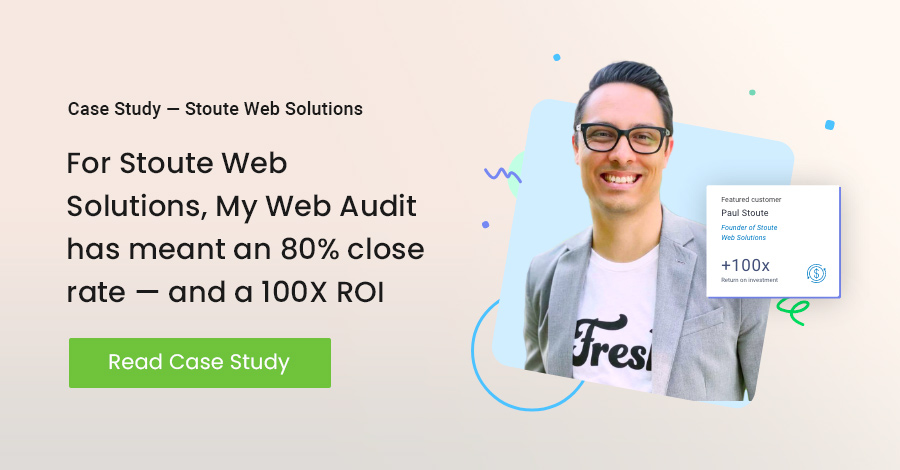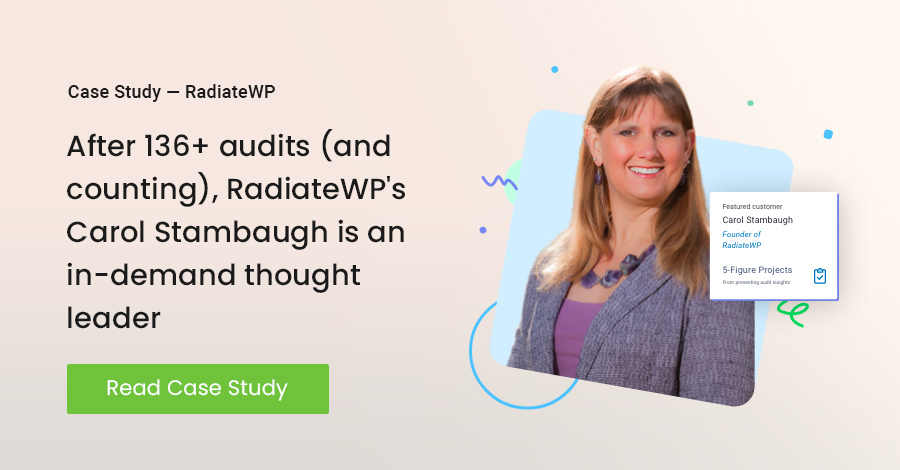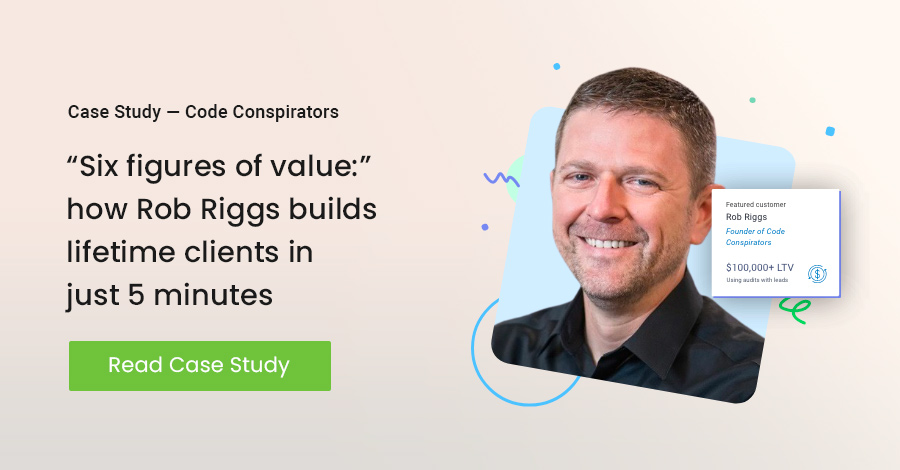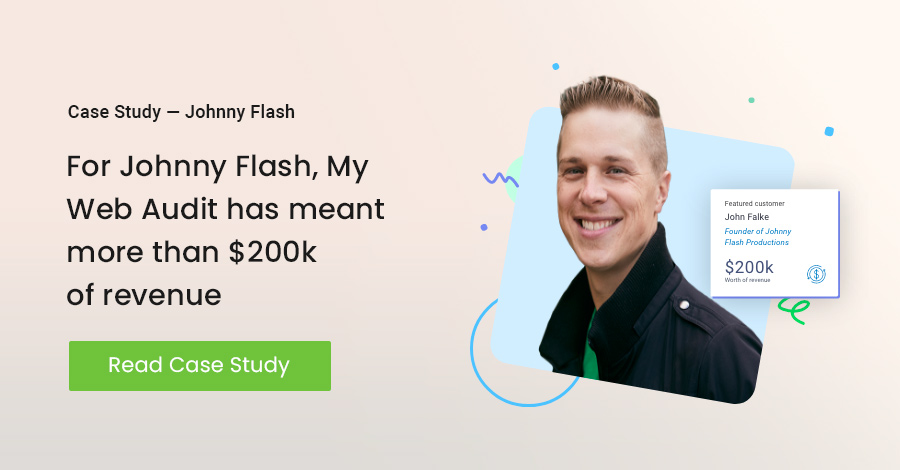
The agency guide to executing discovery
Here is a simple definition for those of you who don't know what discovery is.
Discovery is a process of using your expertise through a series of questions across 4-5 meetings (45-60 mins each) to uncover your client's business pain points/expensive problems, desired outcomes, and goals so you can develop a course of action to solve/achieve those goals.
Here is a high-level overview of what our agency usually covers in those meetings. I've also listed dozens of questions we ask in our discovery sessions further down in this guide.
✔️ Business Overview (USP, Products / Services, Goals, etc.)
✔️ Ideal Customer Persona
✔️ Customer Acquisition Strategies & Value
✔️ Customer Buying Journey
✔️ Business Numbers / Transactional Analysis for Ecommerce
✔️ The Market / Competition
✔️ Technical Analysis & Scope
✔️ Solution Presentation
Our discovery sessions usually start around $1500-2500 for brochure websites and are part of 90% of all new projects we take on. We do apply the discovery fee as a credit towards the website project. We believe that one way or another, proper planning needs to happen, and we want that done before we provide a quote.
One of the common questions we get from prospects and fellow agency owners alike is — Why charge? Let's suppose it's time for your annual checkup at the dentist. Would you expect the dentist to examine your teeth and tell you what needs work… FOR FREE?
Of course not. You'd fully expect to pay for the dentist's time and expertise. You'd certainly pay for an exam, and depending on circumstances, you may even pay for x-rays so that your dentist knows as much as possible about your teeth, especially if you are experiencing pain or care about preventative care.
We're used to paying others for their expertise. We're used to them taking the time to discover our problems and offer solutions. We do this with dentists and other doctors, attorneys, home remodelers, mechanics, and other specialists.
In fact, I'd argue most of us would be terrified if a dentist told us we needed eye surgery after a 20-minute consult. Yet, somehow, there is an expectation to help grow or transform a business's trajectory for years to come based on a 30- 60-minute conversation.
And yet, many agencies still run into problems regarding their own discovery sessions with clients. For example:
- They don't charge for the discovery process, which further devalues the service.
- They ask the wrong questions, so clients don't see the value of the process.
- They rush the process, which leads to unwanted surprises as expectation gaps and scope creep down the road.
Here's the thing…
If you're doing many proposals but are not landing as many clients as you'd like, there's a good chance you aren't using discovery, or your process could be improved. Or if you're landing clients but doing it by slashing your prices, then here too, the root of the problem could be your discovery process.
The good news is that you're about to discover some actionable ways to improve your discovery process – and how to get paid for it. So, let's jump in…
If you choose to do free discovery sessions, that is fine if it works for you. I just wanted to present a guide on how we execute discovery and why we charge for it, and I think you should too.
Table of Contents
Are you doing discovery the wrong way?

Think about your own numbers for a moment. How much time do you spend in a typical month doing discovery and drafting proposals for prospective clients? And how many of these prospective clients do you actually close?
Naturally, these numbers vary across individuals and agencies. Ask 100 different people, and they’ll give you 100 different answers. But those who are struggling with the discovery process know they’re spending too much time on discovery and not landing enough clients to justify that time.
For example, several people I’ve talked to spend somewhere in the neighborhood of at least three to five hours doing discovery, and yet they’re only closing around 20%-25% of clients. If your numbers are anywhere close to that, then you could easily spend several days every month just doing discovery. That’s a lot of time to spend if your close rate is low.
So, let me ask you something: does your process look anything like this?
- Generate a lead. (Yay!)
- Spend 30 minutes on a sales call and try to sell a prospect or spend hours in meetings and calls (for free) in order to discover the client’s needs, answer their questions, and handle their objections.
- Spend more time preparing a proposal. Struggle with pricing. Consider slashing prices to land the client.
- Send off a proposal and cross your fingers. Start worrying about whether you priced too low or too high. Then wonder if you said or did something to scare the prospect away.
- Follow up with the prospect. (Have you looked at the proposal yet? Do you have any questions? Would you like to schedule a follow-up meeting?)
It’s time-consuming, especially if you’re not landing many clients. It can be soul-crushing. And yet, so many agencies figure it’s all just a normal part of doing business.
Guess what? It’s not. If you want to improve this process, then you need to start charging for discovery, and you need to refine your discovery process by asking better questions and focus on delivering massive value in your discovery process. This may require a mindset change on your behalf as well as on your client’s behalf.
Let’s take a look at these two issues more closely…
Why you should be charging for discovery?

As already mentioned at the start of this guide, your prospects are USED to paying for discovery. They do it all the time with their doctors, attorneys, and other professionals. But they may not necessarily be used to paying for it when it comes to web development and marketing.
Why?
Because a whole lot of web professionals and agencies don’t charge for the process or execute it in a manner that delivers value, the industry as a whole has created this expectation. And that’s why you SHOULD charge for discovery. That’s because it sets you apart, lets you do a better job understanding their business, and gets your prospects and clients valuing your expertise. Let me explain…
Position yourself as an expert

When you charge for your time, you get to position yourself as a “consultant” rather than a developer or contractor trading time for the chance to earn some money. You’re not just someone who “builds a website” (which turns your services into a commodity). Instead, you’re an expert who knows how to make your client’s website a success by solving their pain points and, or delivering on their desired outcomes like business growth or better online visibility. And that’s the sort of expertise that’s worth paying for, which is why you should be doing paid discovery.
This brings us to a related point…
Free audit templates to get more leads & close more deals
Easily personalize and use our proven templates for free today. Use to deliver value and build trust with your prospects.
Attract clients who value your expertise

How many times have you offered someone something for free, and they didn’t really value it? Maybe it was an ebook. Or maybe it was free advice. In any case, since it was free, the prospect may have mentally valued it at $0, and didn’t make it a priority to read the guide or take the advice. How many times have you downloaded a free PDF and never read it or a deeply discounted or free course and never gone through it? I’ve got several I never even started…
Guess what?
The same thing happens when you do free discovery. The client doesn’t really value this process. They view it as a series of calls or meetings. To them, you’re “just talking.” And so, they don’t see the value of it. Sometimes they cancel, postpone or rush the calls because they feel like they are doing you a favor by answering your questions.
Now put a price on your time and see what happens. Once you start charging $X for the discovery process, your prospects are going to value the information you’re sharing with them. They’re going to value your expertise. They’re going to trust you (because paid information must be better than free stuff, right?). And all of this is going to make it easier for you to land that client.
Do you know what else happens? You end up with better, higher-paying clients. They tend to be more serious. And they tend to have bigger budgets.
Which brings us to another related point…
Weed out bad clients

How many hours have you wasted doing a proposal for a client who really wasn’t a good fit for your business anyway and ghosted you after you sent it out or presented the proposal? Maybe they had the wrong expectations. Maybe they didn’t have a budget for what they wanted and that wasn’t addressed in the discovery process. Or maybe you just realized they were a difficult client.
It’s disappointing to realize you’re dealing with a bad client AFTER you’ve spent hours working for free to land this client. You may eat that time and expense and refer them to someone else. You may decide to suck it up and do the project anyway (because you need the money). Or as what happens in many cases, maybe the client says no after they’ve seen the proposal.
Here’s the thing…
A paid discovery process can help you weed out these bad clients right upfront. The type of person who doesn’t truly value what you do isn’t going to want to pay for discovery. A person who doesn’t have a decent budget isn’t going to want to pay for it either. And that’s why paid discovery is one of the ways to help you avoid the majority of tire-kicking, time-wasting, difficult clients.
In short: paid discovery helps you reduce a large part of the risk that’s typically associated with the discovery process not being paid for your time. And here’s something else…
Reducing the prospect's risk

When you go through the discovery and proposal process for free with a prospect, part of what you’re doing is a sales pitch where you’re asking them to take out their wallets and spend thousands of dollars with you, maybe even tens of thousands of dollars. That’s a huge risk for any client to take. A lot of their decision-making process is going to be based on who they feel like they can trust.
When you charge for discovery, you’re establishing a client-vendor relationship. They’re paying a fee in exchange for your expertise. Trust grows when money exchanges hands and there is a favorable end result. That means it’s actually easier for you to land the client – after all, it’s easier to get a paying customer to become a repeat customer.
The point is, when you do paid discovery, your clients only need to risk a fraction of their budget (and time) in order to start moving forward. If you’d like, you can even offer to deduct the discovery fee if they decide to move forward with your company. This is what our agency does. In the past five years, of the dozens of discovery sessions we’ve done I’ve only lost one project that paid for discovery that did not lead to more paid work, which is usually a redesign.
Investing enough time

One problem with doing discovery for free is that you probably rush the process, right? After all, time is money – and it costs you a lot to spend hours upon hours doing discovery. This is especially true since it’s all a roll of the dice, as you don’t know if the prospect will ultimately choose you.
You know what happens if you rush discovery: you end up not truly understand your prospective client’s needs. You may end up low-balling the estimate because you didn’t understand the scope of the project.
When you charge for discovery, that gives you the freedom to invest the proper amount of time needed to effectively uncover your client’s needs and goals, this means you can create a more accurate proposal and often charge on value vs. time when solving expensive problems or delivering high-value outcomes. You can create something that’s extremely custom. When you present your prospect with solutions and actionable steps – without any obligation to choose you to execute those steps – you’re creating a whole lot of value.
Naturally, however, creating a better solution also hinges on you asking better questions. When you have the time to do discovery the right way, you can go deep on the who, what, when, why, and how.
For example:
- What’s currently working?
- What’s not working?
- What are the client’s biggest pain points and challenges?
- Who is the audience/what are the customer personas?
- How do you currently reach this audience?
- How do you generate leads?
- How do you close leads?
- How much does it cost to generate a lead (what is the cost per acquisition)?
- What is the lifetime value of a lead to you?
- What are your conversion rates for key metrics?
And so on. When you ask the right questions, you’ll get better answers. And when you get better answers, you’ll be able to blow your prospects away with your insights, analysis, and custom solutions.
Get paid for your time

This one is obvious but so important. You DESERVE to be paid for your time and expertise. When you charge for discovery, you don’t have to worry about rushing through it or guessing about your client’s needs. You don’t have to worry about wasting your time. You don’t have to worry about whether they’ll accept your proposal because you’re getting paid for your time and the value you are delivering. Discovery is one of my favorite services to deliver and is one of our most profitable as well.
Simply put: it’s easier to offer a high-quality service when you’re getting paid for it.
Reduce your sales overhead

Go back to your business numbers. How many hours do you spend doing discovery with prospects for free? And how many of those prospects accept your proposal?
When you do paid discovery, two things happen:
- You’re going to get paid for this time. No more working for dozens of hours for free each month.
- You’re going to close more sales. And that means your cost per acquisition is going to drop and your ROI goes up.
In other words, doing paid discovery is a sound business decision. And if you’ve been paying attention to this guide so far, then you’re probably getting fairly excited about the idea of doing paid discovery.
So, let me share with you some tips and tricks for making this even easier for you…
Optimizing your discovery process
The key to receiving all the benefits described above is to be sure both you and your client are getting the most out of the discovery process. I’ll be sharing how we do that in our agency discovery process below. I’ve also included some lessons I’ve learned along the way to get better results.
Consider offering a free, limited consultation

If the clock starts running the second a prospect speaks to you, someone who’s still in the information-gathering mode may shy away from approaching you. That’s why you may consider offering a free 30-minute consultation.
This is a win-win proposition. You win because you’ll never waste more than 30minutes on a call that’s going nowhere. Your client wins because they can get a taste of what you offer with no risk. And you both win because it’s a no-risk way to see if you and your prospect are a good fit.
Our agency sales process usually requires the prospect to fill out a short intake form before this call so we can better understand their needs as well as qualify the lead. We run one of the many audits we use in our agency from here and then present some of the key findings on the strategy call to deliver value, establish trust and expertise.
Don't start immediately

You may be tempted to tell clients you can start their project today. You may even think that’s a selling point. However, it’s better to tell clients that you need to do some additional research before you get started. This not only shows you’re conscientious and professional but not starting immediately also implies that your services are in demand. We try to schedule the strategy call within 1 business day of them reaching out and discovery sessions within 3-5 business days after the invoice is paid in full.
Experiment with your prospects and clients

If you’re not exactly sure about the best way to approach different parts of the discovery and proposal process, then start testing out different methods with different clients. Track your results to see which approaches work the best for you since your agency is unique, and so is your ideal customer/industry you serve.
It’s also a good idea to get feedback from clients who’ve decided to go with another company. Getting feedback will help you refine your process so that you have a better chance of landing the next client.
Ask the right questions

Sometimes you’re going to run into a prospect who seems to believe they know it all. They may even try to derail the discovery process by trying to tell you how to do your job.
If it’s clear this is going to be a difficult client, cut them loose. Otherwise, counter by asking a lot of questions. For example, “What are your experiences with this strategy?” or, “How did you come to this conclusion?” Whenever possible, ask them about the numbers (the metrics) that back their claims.
These questions will let you lead prospects through the process and show them what they don’t yet know. This positions you as the expert who can help them solve their problems.
Here are some of the key questions and categories we cover over in our discovery sessions. I hope that you can add to your list or begin one.
About your business
- What is your Unique Selling Point / Value Proposition?
- What are their desired outcomes or pain points?
- What are your products/services? (List them all in bullet format in order of most profitable).
- What are some common questions that your customers ask about your product/service?
- What are common objections you deal with from converting leads to customers?
Customer persona
- Your ideal customer profile (Age range, gender, income/revenue, geographic location).
- What do you know about spending habits?
- Personality traits to uniquely identify them?
- What other products/services do they use?
- What market do you consider this customer in?
- Negative Persona. Who don’t you want as a customer?
- How long does it take to potentially close a lead?
Customer funnel
- What persuades a customer to buy their first product/service from you?
- What are the sources of getting leads for the first transaction?
- What brings the customers back for additional products/services? (Your outreach, their needs).
- What results do customers expect to achieve as a result of buying your products? (Solution for a problem, addressed a pain point, improved their life, educated/empowered the customer).
Leads & CRM
- CRM: Do you use a Customer Relationship Manager (CRM) to store leads that come in? Which one?
- Prospect: What happens to a lead from the moment they contact you?
- How do you use the CRM to engage your prospects & customers? (Newsletters, educational material, promotional material, etc) How often?
- Follow Up: Who manages your CRM?
Existing website
- Is there a website that best represents what you want?
- What do you love about your existing site?
- What do you hate about your existing site?
- Who built your current site?
- Why aren’t you looking to hire them?
Content creation & marketing
- Content Strategy.
- Do you currently have a content marketing strategy?
- What terms would your ideal customer search for to find you?
- What search terms are you targeting organically using content, SEO or paid channels?
- How do you create and promote your content?
- Do you have someone who can create and optimize content for search engines?
- What channels will you use to push content once it’s published?
Online business / competition online
- Who are your key competitors?
- Rate your primary competitor’s web design.
- Rate your competitor’s marketing strategy if you know anything about it.
- What do you think they do better than you?
Historical strategies/tactics
- What have you done in the past that has worked?
- Is your marketing effort driving sales?
- What hasn’t worked?
- What have you thought about doing but never did?
- Why didn’t you do it?
- List current strategies.
- List future strategies.
- How will this project assist in your current and future strategies?
- What is your current growth strategy?
Competitive advantage
- How can your particular product/services help prospects, compared to others in your industry?
- What’s special about your business experience/qualification that differentiates you?
- What is your company/brand’s promise to the customer?
Measurable success
- Business objectives need to be transformed into measurable success criteria. E.g. an objective to increase sales could become a measure of success that specifies a 20% increase in repeat orders within 6 months. Without measurable goals it is difficult to know whether the project has generated a return on investment.
- What are some good objectives to measure success in your business with the new campaign we are launching?
Transactional assessment
- How many customers do you support monthly?
- How many new leads do you currently get each month?
- What is your average cost per lead?
- Where are the sources for your leads?
- What percentage of prospective leads become customers?
- What is your average transaction value of a customer?
- How many transactions on average do you have with each customer?
- What percentage of your business is from new clients vs. repeat?
Join our agency owners facebook group
If you are interested in topics like agency lead generation, sales, growth, and entrepreneurship join the conversation in our Closed FB Mastermind for Web Professionals and Agency Owners. Feel free to invite your friends or colleagues if you feel they’d benefit from it as well.
Offer tiered pricing

When you offer paid discovery, your prospects generally have two options: yes they’ll pay for discovery, or no, they won’t pay for discovery.
We’ve found it helpful to present two options with different price points and deliverables and recommend which we think is best for the prospect. Our higher-end discovery also includes us walking our prospect through Story Brand and helping them clarify their messaging for their site and marketing.
The goal is to provide your prospects with options that work based on needs and budget while ensuring you can help them and get paid well for doing so.
Remember — you are the expert

You’re the expert. That’s why a prospective client has approached you. And that’s why you shouldn’t be afraid to disagree with your prospects or clients (politely, of course) about what they need or the best way to achieve their goals especially when you know their approach could harm their business. Take the time to understand them, then educate them, remember sometimes a mindset shift needs to be made on their end because they may have been told something different before, been burned by a dodgy service provider, or something else.
End result? Trust grows… and you’ll land the client because they respect you.
Decide on a discovery fee

You may charge a flat fee based on your hourly rate and how much time you’re likely to spend on the discovery process. Another way to figure it out is to charge about 20% of the price of your average project. So, if your average project is around $5000, Then you might charge around $1000 for discovery.
Avoid sharing estimates upfront

You know how it is—prospective clients are going to come to you asking for a ballpark. And they want to know this estimate BEFORE you go through the discovery process. They might even promise they won’t hold you to that estimate.
Don’t share a number if they request you provide on, then provide a broad range based on what you’d usually charge for similar work. Explain how you can’t give an accurate estimate without examining their business anymore than a mechanic can give you an estimate without examining the car.
I do my best to emphasize that any agency or consultant that is willing to give them a quote based on a 30-minute call and does not take time to understand the business or their problems will deliver a beautiful brochure site at best. It will not be an effective sales and marketing resource that actively helps grow their business.
Which brings us to the next point…
Do collaborative estimation

If you’re the one directing the entire process, including the investment needed, then you put your client in the position of simply saying “yes” or “no” to the budget. (And you know how easy it is to say “no.”)
So, here’s what you do instead: bring the client into the process. Around the third meeting after you’ve established rapport and built some trust ask them what sort of budget they have allocated for the project.
The way we have the budget conversation is to tell them we build sites from $10K-100K+ often times it is primarily the site features and functionality that determines the investment. In order to avoid time discussing features and functionality that may not be needed or maybe out of their budget, we ask them for a range they’d like to stay within.
This is strategic because the third meeting is usually when we discuss technical specifications and scope of work.
Have them tell you what they need and why, along the way document those needs and associate a dollar amount to them.
End result? You get a key list of things your prospect wants, they tell you why it’s important for them and what not having it has cost them. You are able to then position the value your agency brings to resolve their problems and help them get to their desired outcome.
This is done in a collaborative manner and this framework creates a mindset change that gets your prospects invested and when done right will lead to you closing more of the clients in your discovery sessions into high-value projects where the business is both happy and excited to work with you.
Solutions presentation

Our last discovery meeting is called the Solutions Presentation. It is where we present the following via an in-person meeting or Zoom call along with a PowerPoint presentation:
- Our analysis of the current website and what the new site should include.
- Marketing strategies we recommend they consider.
- Overview of their ideal customer persona.
- Story Brand outline (If they opted for this add-on).
- Summary of the scope of work.
- Project Investment.
- Q&A / Next Steps.
At this point, if the client has any questions or needs to adjust the scope or budget we try to do it on this call and get verbal approval before working up a project agreement or proposal for them to sign, pay to kick off the project. Getting the verbal approval is key, we don’t want to waste time working up all the details only for them to ask for some of it to be removed or them mention it’s over what they expected to invest in your services. Make sure to tie their requests to the scope of work and align everything with their pain points and desired outcomes. You want to leave the Solutions Presentation with a YES!
TIP: Make sure all key decision-makers are involved in your discovery process and are present for the Solutions Presentation.
Generate actionable discovery insights & talking points
In 5-10 minutes our app can generate dozens of actionable recommendations around UI/UX, SEO, CRO, performance, and security specific to your leads and customers.
Offer an exit

When you present your client with the discovery information (which they’ve paid for), you can now give them the option of exiting the relationship or you can as well if they aren’t the type of company you’d like to continue with. They can take the actionable steps you’ve provided and ask another vendor to complete them. If that happens, you can thank them for their business, and make a note to follow up with them in a couple of weeks.
Chances are, however, your client is going to ask your team to perform the work. You’ve taken the time to truly understand their business, you’ve developed trust, and you’ve provided value… They’ve invested time and money with you. This in turn leads to a much higher probability that they will proceed with you for the project vs. go look for someone else.
Now let’s wrap things up…
Conclusion
As you can see, using a paid discovery process can be really beneficial to both you and your prospects for these reasons:
- You get paid for what you’ve already been doing.
- It reduces the risk for both you and the prospect.
- It builds trust, which leads to closing more sales.
- It helps you weed out bad clients, and it attracts good clients who’ll spend more money with your company.
- It positions you as the expert.
- It gives your prospects a lot of value.
In short, it just makes good business sense to start offering paid discovery.
As mentioned, you’re able to close more sales when you use paid discovery. That’s because the process lets you demonstrate that you can bring custom solutions and actionable steps to your prospect. Instead of giving prospects a cookie-cutter set of solutions, you’re taking the time to develop personalized solutions to fit their needs.
While an in-depth discovery process takes time, you can start the process in as little as five minutes by doing a web audit. Like the discovery process itself, a web audit lets you start identifying the client’s needs and providing actionable steps.
Now here’s the good news…
In the past, you needed to use multiple clunky tools in order to create your web audit, and then you still needed to compile the information into a report. Today thanks to MyWebAudit.com you can use ONE tool to quickly and easily create a beautiful report in as little as five minutes from now. And you can charge for this report as part of the discovery process.
Want to see just how easy it is to create these audits and how well they work to help you close the sale? All you have to do is click the following link to get started with a free trial: www.mywebaudit.com.
Check it out now, because you’re going to like what you see!
Additional discovery resources
Over the past decade, I’ve invested tens of thousands of dollars and hundreds of hours leveling up my agency processes, mindset, and growth strategies. This guide is a byproduct of that. The good news is that nowadays there is no shortage of great content you can learn from. Here are some resources I think could help you with your discovery process.
- The Paid Discovery Class: A Complete Guide to Selling and Running Paid Discovery — The Admin Bar
- What to Ask During Website Discovery + Website Discovery Workbook — Agency Trailblazer
- How To Explain Paid Sales Discovery To Your Web Design Prospects — UGURUS
- How to Get Paid for Your Discovery Sessions — Agency Mavericks
- What To Include In Your Website Discovery Questionnaire —Jennifer Bourn
Join our FB agency community
If you are an agency owner or web pro who is interested in topics like agency lead generation, sales, growth, and entrepreneurship. Join us for free!
You may also like
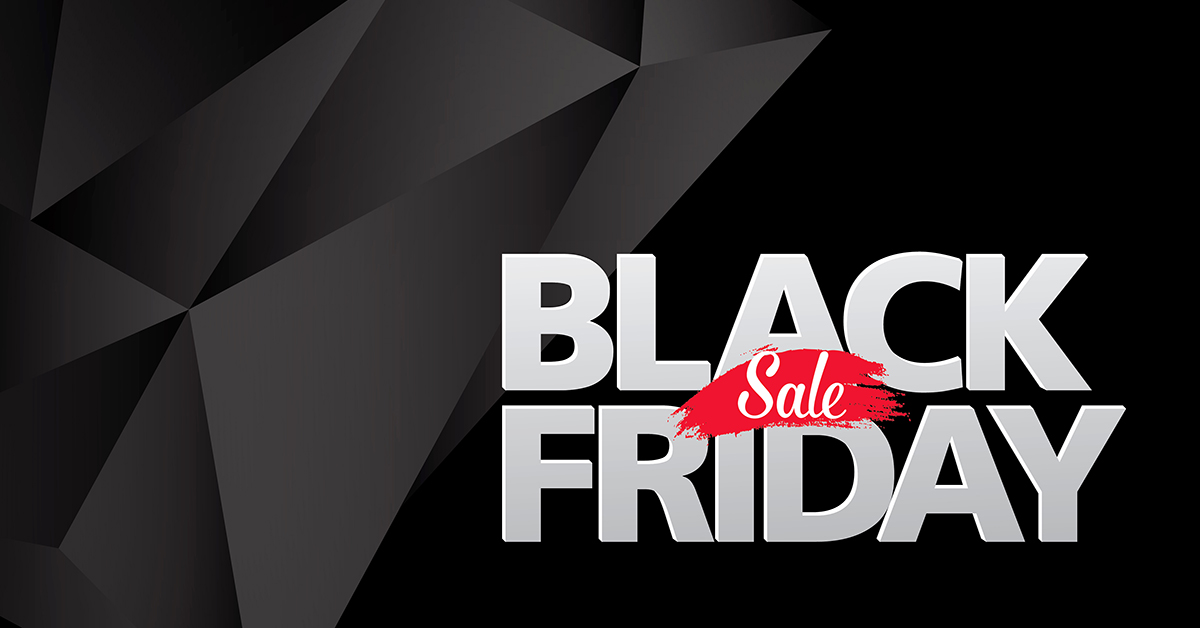
Black Friday + Cyber Monday deals for agencies
Black Friday is the ultimate opportunity for freelancers and agency ow...
Learn more
Agency Guide: How To Generate Leads From Trade Shows & Conferences
Trade shows and conferences can be great opportunities for agencies to...
Learn more
















